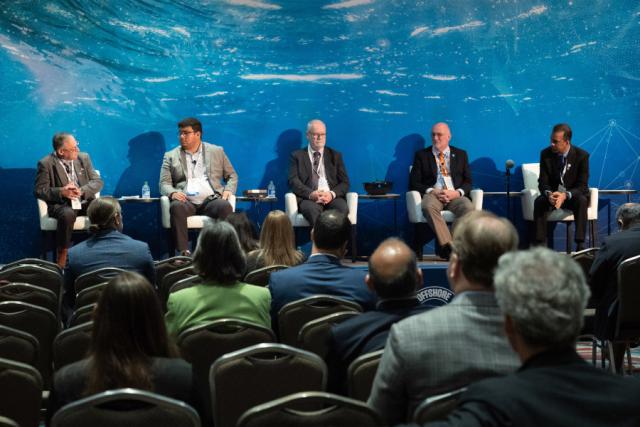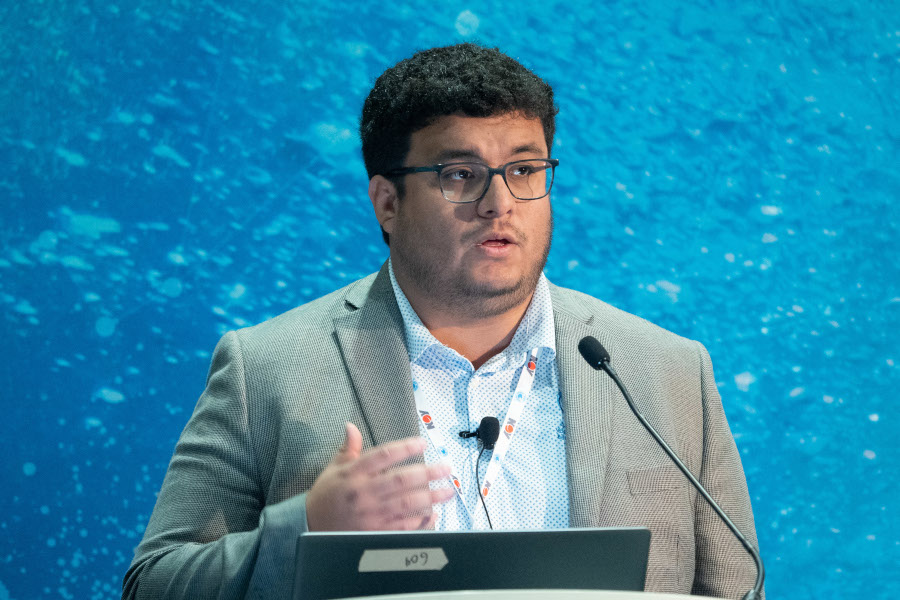
Panelists discuss the advantages and risks of AI at the Offshore Technology Conference. Left to right: Moderator Donald Forgie, Occidental Petroleum; Marco Castillo, Abyss Solutions; Dave Finn, Energy Research & Innovation Newfoundland and Labrador; Anthony Patterson, Virtual Marine; and Mansoor Nazar, Occidental. (Source: OTC)
Artificial intelligence (AI) is becoming more and more commonplace in our society—found in our cars, phones, vacuum cleaners and home ovens. AI provides a certain level of ease with daily life, and its only a matter of time before its rise in the oilfield becomes near ubiquitous.
“We all use tools like ChatGPT on our day-to-day productivity,” said Mansoor Nazar, director of Enterprise Architecture and Emerging Technologies at Occidental Petroleum, said during a May 4 panel at the 2023 Offshore Technology Conference (OTC). “We know how much value it adds, we know how much time it saves. Why not implement that with work, with our work as well?”
During the Center for Offshore Safety: How AI is Supporting Industry in SEMS panel at 2023 OTC, industry experts discussed the growing impact of AI in the oilfield. While the panelists agreed about the plethora of benefits that artificial intelligence can bring to the industry, they were cautiously optimistic about the utility of less-than-perfect AI.
Panelist Marco Castillo, product manager for Abyss Solutions, gave an example of dependency on an AI module for visual detection.

“One of the biggest problems you have, even with visual inspectors today, is that it's kind of a ‘thumb in the wind’ approximation of what they can see,” Castillo said. “Maybe [the computer] can't get to a certain spot to make an evaluation. Maybe the computer is a little bit better at targeting things in between the legs of chairs or through a couple of pipes… How do you start to make an evaluation that is high enough fidelity, that it's meaningful, to the point where you could compare it to something like non-destructive testing?”
Trusting AI is a big step for operators—and workers—simply because they don’t share the same experience that humans have, and never will.
One way to mitigate AI’s inexperience is through point cloud segmentation, Castillo said.
Point cloud semantic segmentation is the process of associating each point in a point cloud with a semantic label, such as a person, vehicle, pipe and so forth. Combined with its machine learning capabilities, the AI receives so much data that it’s familiarized with most—if not all—of the components in the process it is trying to complete.
The method isn’t foolproof, but Castillo said he believes it will create an intelligent system with interactions “at a competent level.”
But Nazar said, AI still faces a greater problem that has yet to be solved: bias.
“It may not be up to an organization or an individual to fix that problem. Not only [are] humans interacting with the AI or training it, but your past data might be biased. So all the historical incidents and the data that you've collected, it had bias built into it. And that is the data your AI is learning [from],” Nazar said.
One possible way to combat the inherent bias in AI, Nazar suggested, is to be completely transparent with all the data put into AI. By making that information “auditable,” programmers will be held responsible for any mistakes made.
If AI is to live up to its potential to be a positive force in the energy industry, it needs such improvements and developments.
A prime example: AI’s ability to map external corrosion.
The traditional process for corrosion detection, described by Nazar, involves contracting a fields inspector to fly to an offshore facility and walk the ship, looking for signs of corrosion. A report is then provided to operators who would then work to remedy any problems.
AI cuts the human from the equation.
“You have your LIDAR scanners, your drones, your high-resolution cameras or your robots walking around with cameras equipped on top of them. And all they are doing is capturing photogrammetry. They're just capturing imagery and they're running back,” Nazar said. “We can do this on a more frequent basis because it will capture the imagery and any change in the facility will require recapture of that area. Once you have all of that data captured, that data gets uploaded to a cloud environment… Then you can run some algorithms on it to detect corrosion.”
Despite the complexity of the task, an AI programmed correctly would be capable of handling the inspection. While AI can’t actually clean or manage the maintenance aspect of corrosion detection—maintenance workers will still be responsible for that—it saves both time, money and has the potential to bring a new level of safety to the field.
Recommended Reading
Shell’s CEO Sawan Says Confidence in US LNG is Slipping
2024-02-05 - Issues related to Venture Global LNG’s contract commitments and U.S. President Joe Biden’s recent decision to pause approvals of new U.S. liquefaction plants have raised questions about the reliability of the American LNG sector, according to Shell CEO Wael Sawan.
Mexico Pacific Appoints New CEO Bairstow
2024-04-15 - Sarah Bairstow joined Mexico Pacific Ltd. in 2019 and is assuming the CEO role following Ivan Van der Walt’s resignation.
BP Pursues ‘25-by-‘25’ Target to Amp Up LNG Production
2024-02-15 - BP wants to boost its LNG portfolio to 25 mtpa by 2025 under a plan dubbed “25-by-25,” upping its portfolio by 9% compared to 2023, CEO Murray Auchincloss said during the company’s webcast with analysts.
BP Restructures, Reduces Executive Team to 10
2024-04-18 - BP said the organizational changes will reduce duplication and reporting line complexity.
Aramco Reports Second Highest Net Income for 2023
2024-03-15 - The year-on-year decline was due to lower crude oil prices and volumes sold and lower refining and chemicals margins.






